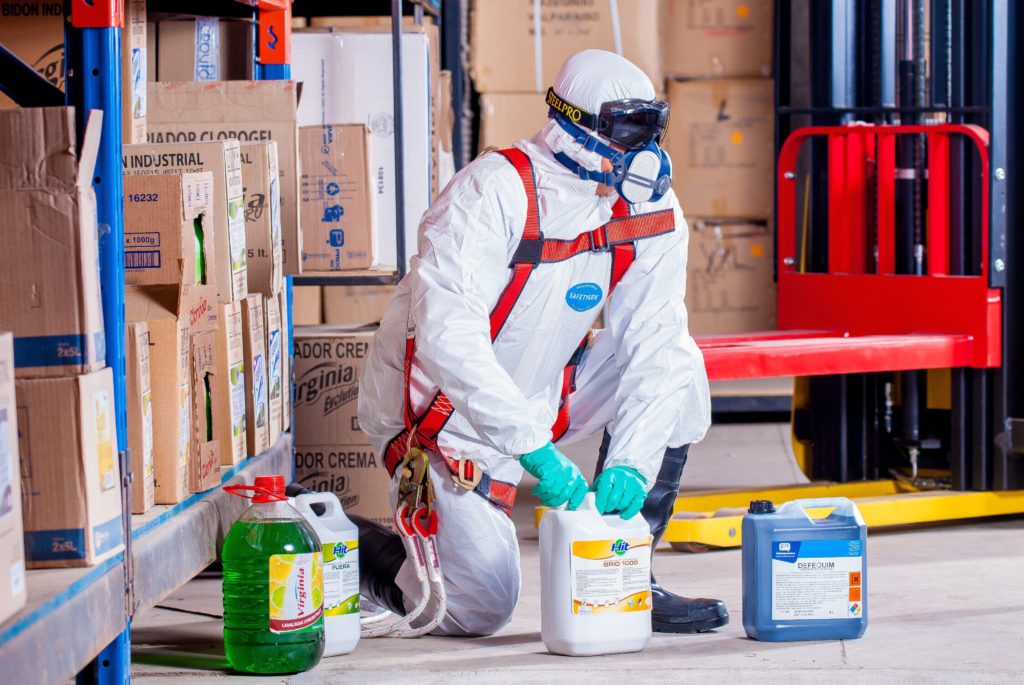Chemicals don’t stay in their containers. Between 2009 and 2018, 65,000 people died due to uncontrolled releases of chemicals. These incidents included explosions, oil spills, and food contamination.
Chemical Hazards
If you work with chemicals, you should expect a chemical spill. It’s not easy to prepare for one, but you can make a multi-step plan. What preventive measures can you take? What kinds of hazards can chemicals pose? Answer these questions and you can stop a chemical spill from ruining your workday. Here is your quick guide.
Prevent a Chemical Spill Before One Happens
Every business that uses chemicals must develop a spill plan. It should address each chemical that the business uses, including non-lethal ones. It should provide a contact list of all individuals who must respond to the incident.
If possible, include a floorplan of each room where chemicals are stored. Draw where personal protective equipment and first-aid kits are. Stock each room with enough supplies to protect everyone inside.
Understand Different Chemical Hazards
Each chemical hazard symbol is important. They indicate what risk a person faces if the chemical is improperly used. A health hazard is toxic to organ function. It can cause cancers or harm the respiratory system. The chemical usually induces damage over time.
But some chemicals can cause more immediate problems. They can damage the eyes or skin if they make contact. These chemicals are marked with an exclamation mark or a skull and crossbones.
Most chemicals will catch fire if exposed to flames. But some chemicals can ignite themselves if they are exposed to water or air. Sodium is an example of a chemical hazard that self-ignites.
Some chemicals must be stored under pressure. These include ammonia. The chemical hazard label for these chemicals contains an image of a gas cylinder.
Your spill plan must detail preparations for each type of hazard. You should communicate with all of your employees about each one.
Make sure you can store each type of hazard in proper containers. You should also have good refrigerators and sturdy shelves that don’t shake. If you cannot provide these resources, you should not have chemicals on-site.
Control the Scene
A spill requires a prompt response. You must control the scene so the spill does not spread and hurt people. Start with ways to stop a spill. If a container has fallen over, put on personal protective equipment. Then walk over and put the container back up.
Shut down all sources of heat in the room, even on the other side. You may need to turn off lights or appliances to do so. Increase airflow through the room. Try to avoid opening the windows, as the spill may spread toxic fumes. Turn on overhead fans and open up floor drains. Stop all work with other chemicals. Ask workers who are nearby to step away so you can avoid injuries.
Contain the Disaster
You need to prevent the chemical from contaminating surfaces. The best way to do this is to spread absorbent materials.
Hydrogels work for most chemicals. You can also use inert substances like vermiculite that absorb moisture. Do not use water or a rag since that could cause a fire.
Spread the absorbent substances around the edges of the spill. This will keep it from expanding. Then sprinkle them toward the centre and wait for them to soak the chemicals up.
Your first instinct might be to let the chemicals flow into a drain. This can dump them into a waterway or destroy piping. You should absorb the chemicals instead and deposit them through another means.
Evacuate
You should rehearse evacuation drills every month or so. Practice a few different kinds of drills, including full building evacuations. This may sound excessive, but you need to prepare for all kinds of spills.
For a minor spill, non-essential personnel should leave the room. They should wait outside of the building before being allowed back in. Waiting in a hallway can impede emergency responders.
If a chemical is very toxic or if you cannot contain the spill, all personnel should leave. They should don protective equipment and get out of the area as soon as possible.
Talk to everyone else in the building if such an evacuation is underway. They may need to leave as well. You should also inform other buildings in the area, including residences.
Call emergency responders, even if no one has visible injuries. Someone may have breathed in fumes that have caused internal injuries.
If someone is injured, give them care. Make sure their airway is clear and avoid moving their head and neck if possible.
Clean Up
You should clean up the spill only when the scene is safe. A small spill requires few precautions. You can use a broom to sweep up solid materials that have fallen on the floor. But you may need to clean or dispose of it afterwards.
Make sure to disinfect any surfaces that the chemicals touched. You can use bleach or detergent in most cases. Larger spills require more resources. Contact a service that specializes in cleaning up large spills, like HCI Environment.
Stop a Chemical Spill in Its Tracks
A chemical spill is a sudden event. Prepare for one well in advance. Draft a spill plan that includes a floor map of where your protective equipment will be.
Each chemical presents its own hazard. Make sure you can contain each one. Control the spill by increasing ventilation. Then contain the scene with absorbent substances.
Get non-essential personnel out of harm’s way. When in doubt, evacuate the entire room and building. Clean the spill after the scene is secure. Don’t take a half-hearted approach to safety. Follow our coverage for more security guides.
